Search results for: 'Art'
-
 Elamite horse rhyton
Elamite horse rhytonFascinating clay vessel in the shape of a horse from the Neo-Elamite period, around 700 BC. A TL analysis report is included with the piece.
Price: on request Luristan bronze dagger
Luristan bronze daggerIron Age bronze weapon originating from the Luristan region in Ancient Iran. Well preserved.
€1,250 Byzantine glass pendant from Judaea
Byzantine glass pendant from JudaeaThe pendant with a lion and crescent motif was worn as a lucky charm or protective amulet. Made in the early Byzantine period in a glass workshop in Judaea.
Price: on request Byzantine glass pendant from Judaea
Byzantine glass pendant from JudaeaThe pendant with an ibex motif was worn as a lucky charm or protective amulet. Made in the early Byzantine period in a glass workshop in Judaea.
€185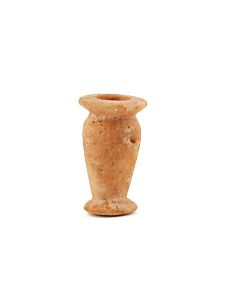 Alabaster vessel
Alabaster vesselSlender container made of beige stone. From the Eastern Mediterranean.
Price: on request Persian bowl from Golestan
Persian bowl from GolestanNicely decorated with plant ornaments in black and turquoise. Made towards the end of the Islamic Golden Age in the Persian province of Golestan.
Price: on request Rollsiegel aus der Akkad-Zeit
Rollsiegel aus der Akkad-ZeitSiegel aus Achat mit Maserung in Braun- bis Cremetönen. Abrollung zeigt mythologische Szene. Ende 3. bis Anfang 1. Jt. v. Chr., womöglich Akkad-Zeit.
Price: on request Sasanian stamp seal
Sasanian stamp sealVery nice dome-shaped seal made of stone. The piece is from the period of Sasanian rule in the Near East.
€350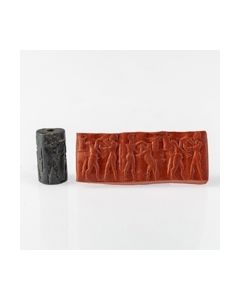 Cylinder seal from Old Assyrian trade outpost
Cylinder seal from Old Assyrian trade outpostWonderful example for the style of the Old Assyrian trade colonies in Anatolia. Well-known from Kültepe Level II. It shows a fighting scene between hero and bull man. Around 1900 BC.
Price: on request Old Assyrian cylinder seal from Anatolia
Old Assyrian cylinder seal from AnatoliaInteresting seal with religious scene. From an Old Assyrian trade outpost in Anatolia. It shows a god on a throne with goat feet.
Price: on request Roman ribbed glass flask
Roman ribbed glass flaskFantastic and rare type of vessel from the Roman provinces of the Levant. Ex professor Ritschel collection.
Price: on request Roman sprinkler
Roman sprinklerPerfume bottle with pattern-blown body. An aperture made it easy to dispense the precious content drop by drop. From the Late Roman period.
Price: on request Roman glass rod
Roman glass rodThe object had a function as a distaff, a tool for spinning. Particularly noteworthy is the beautiful spiral decoration and the complete preservation of the fragile material. From the Roman Imperial period.
Price: on request Necklace of Egyptian mosaic glass beads
Necklace of Egyptian mosaic glass beadsModernly threaded necklace of ancient beads of spherical and cylindrical shape made of beautiful mosaic glass. From a workshop in Roman Egypt. Ex Christie's.
€5,100 Eastern Roman glass bottle with thread decoration
Eastern Roman glass bottle with thread decorationA product from the Roman province of Palaestina. The high-quality glass was created in the 6th to early 7th centuries, when the Eastern Roman Empire was thriving and the Byzantine Empire took shape.
€2,300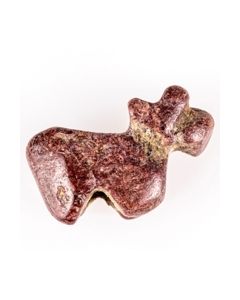 Sumerian miniature ram amulet
Sumerian miniature ram amuletNice small stone amulet in the stylized shape of a ram. From the 3rd Millenium BC.
Price: on request Sumerian miniature ram amulet
Sumerian miniature ram amuletNice small stone amulet in the stylized shape of a ram. From the 3rd Millenium BC.
Price: on request Massive bronze figurine of a bull
Massive bronze figurine of a bullPerfectly preserved, undamaged, with brown-green patina. Acquired 1978 at Davies Antiques Gallery, London.
Price: on request Einhenkliger Keramikkrug aus dem Nahen Osten
Einhenkliger Keramikkrug aus dem Nahen OstenDer Körper in Form eines Granatapfels, unten zu einem Standfuß abgeflacht. Hellorangefarbene Keramik. Fund von der Levante.
Price: on request Großer Krug mit Bemalung
Großer Krug mit BemalungFrühe bis mittlere Bronzezeit, 3. bis 2. Jt. v. Chr. Dickwandiges Tongefäß aus Jordanien mit schwarzer Bemalung und seitlichem Henkel. Höhe 225 mm.
Price: on request Nahöstlicher Keramikkrug
Nahöstlicher KeramikkrugGroßer Krug aus hell beigefarbener Keramik, fast 20cm hoch. 1500 bis 500 v. Chr., Späte Bronzezeit bis Eisenzeit.
Price: on request Amphoriskos aus der frühen Bronzezeit
Amphoriskos aus der frühen BronzezeitKugelförmiges Tongefäß mit gekerbtem Dekor aus Jordanien. Rußspuren an der Unterseite weisen auf die mögliche Verwendung als Kochgeschirr hin. 3100 v. Chr. bis 2200 v. Chr.
Price: on request Sidonian perfume bottle
Sidonian perfume bottleGlass from Sidon with a decorative relief of amphorae and other vessels. A phoenician production from the 1st century AD.
Price: on request Clay impressions of Roman seals
Clay impressions of Roman sealsThe ancient impressions in clay are from papyrus documents issued and sealed in Roman times. A fantastic testimonial to Roman bureaucracy.
Price: on request Persian jug from Sultanabad
Persian jug from SultanabadImpressive pottery with turquoise glaze and black paint. From 13th century Iran. With a letter from the Royal Victoria and Albert Museum.
€1,040 Iron Age pottery vessel in the shape of a tiger
Iron Age pottery vessel in the shape of a tigerFantastic animal shaped vessel with the mouth serving as a spout. From Iron Age Azerbaijan. The piece comes with a TL analysis from 1981.
Price: on request Sumerian foundation cone from Uruk
Sumerian foundation cone from UrukSmall conoid clay nail with cuneiform inscription. From the main temple of Uruk, that is also mentioned in the Epos of Gilgamesh. Circa 3rd Millenium BC.
Price: on request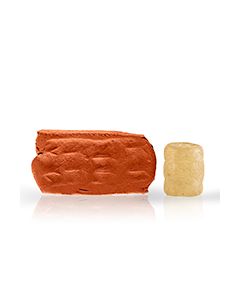 Near Eastern cylinder seal with fish
Near Eastern cylinder seal with fishThe beige seal shows three groups of stylized fish. Am artefact from Bronze Age Mesopotamia or south-west Iran.
€520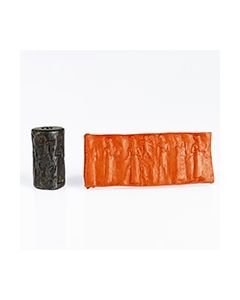 Rare cylinder seal with Old Babylonian and Old Assyrian engravings
Rare cylinder seal with Old Babylonian and Old Assyrian engravingsThis seal from Old Babylon has been reworked in Old Assyrian style, probably in Anatolia or Northern Syria. It tells a story of political and cultural diversity in the ancient Near East.
Price: on request Bronze votive figurine of a bull
Bronze votive figurine of a bullNicely preserved bronze figurine. 2nd - 1st half 1st millenium BC. Bronze or Iron Age, Western Asia, probably Hittite.
Price: on request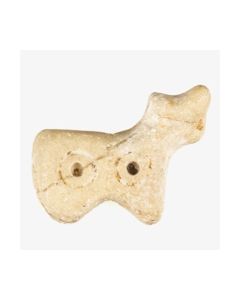 Sumerian ram amulet
Sumerian ram amuletNice small stone amulet in the stylized shape of a ram. From the 3rd Millenium BC.
Price: on request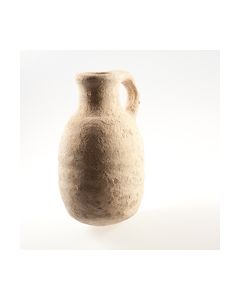 Schöpfkännchen aus der Lachisch III-Zeit, Palästina
Schöpfkännchen aus der Lachisch III-Zeit, PalästinaKrug mit seitlich angesetzem Henkel. Fund aus Palästina, Gefäßtyp aus Südpalästina. Perfekt erhalten. Mit originalen Fundablagerungen.
Price: on request Tongefäß aus der frühen Bronzezeit
Tongefäß aus der frühen BronzezeitFrühbronzezeitlicher Gefäßtyp. Vermutlich für Wasser, Öl oder sonstige Flüssigkeiten verwendet. Dezente Verzierungen. Ca. 3100 v. Chr. bis 2900 v. Chr.
Price: on request Keilschrifttafel aus der Ur III Zeit
Keilschrifttafel aus der Ur III ZeitMesopotamische Tontafel aus Ur mit administrativem Text in Keilschrift. Die Tafel datiert in die Zeit des Königs Shu-Suen (auch Shi-sin), der während der 3. Dynastie von Ur in Sumer und Akkad regierte. Der Text hält die Ausgabe von Essensrationen fest, namentlich die Menge eines Getreideeintopfes, die an 15 weibliche Mehlmahlerinnen ausgegeben werden soll. Jede von Ihnen hat 6 Quart zu erhalten, wobei die Gesamtmenge 90 Quart zu betragen hat.
Price: on request Tongefäß aus der frühen Bronzezeit
Tongefäß aus der frühen BronzezeitFrühbronzezeitlicher Gefäßtyp. Vermutlich für Wasser, Öl oder sonstige Flüssigkeiten verwendet. Rußspuren durch Befeuerung. Ca. 3100 v. Chr. bis 2900 v. Chr.
Price: on request Tongefäß aus der Bronzezeit
Tongefäß aus der BronzezeitVermutlich für Wasser, Öl oder sonstige Flüssigkeiten verwendet. Ende Frühe bis Mittlere Bronzezeit. Ca. 2500 v. Chr. bis 1500 v. Chr.
Price: on request

